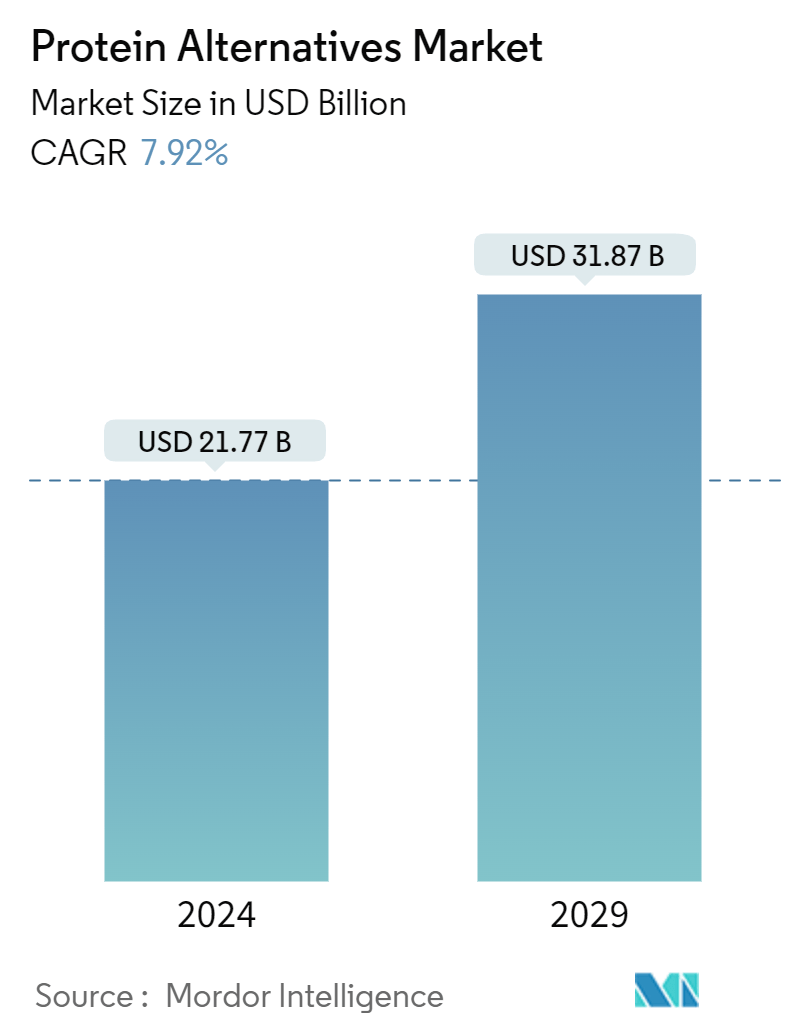Market Size of Protein Alternatives Industry

| Study Period | 2019 - 2029 |
| Market Size (2024) | USD 21.77 Billion |
| Market Size (2029) | USD 31.87 Billion |
| CAGR (2024 - 2029) | 7.92 % |
| Fastest Growing Market | Asia Pacific |
| Largest Market | North America |
Major Players
*Disclaimer: Major Players sorted in no particular order |
Protein Alternatives Market Analysis
The Protein Alternatives Market size is estimated at USD 21.77 billion in 2024, and is expected to reach USD 31.87 billion by 2029, growing at a CAGR of 7.92% during the forecast period (2024-2029).
Consumer preferences are changing globally, and European and North American consumers have a low inclination toward meat and meat-based products. The increasing number of consumers becoming more flexitarian or vegan offers great opportunities for manufacturers to introduce and innovate more in the plant protein segment. Demand for alternative proteins is fueled by forces ranging from health concerns to climate action and the increasing awareness of ethical issues in factory farming.
The emergence of novel protein sources such as algae, fungi, and insects is gaining traction as alternative sources offering unique nutritional profiles, environmental benefits, and culinary possibilities, presenting new opportunities for product development and market differentiation. Companies are exploring these novel protein sources and investing in research and development to commercialize innovative protein products to meet consumer demand for sustainable and nutritious alternatives. Further, alternative protein manufacturers are also growing strongly. New entrants are applying disruptive technologies, such as synthetic biology, Big Data, AI, machine learning, robotics, and the Internet of Things, to gain a competitive edge in the market.
Protein Alternatives Industry Segmentation
Protein alternatives are protein-rich ingredients sourced from plants, insects, fungi, or through tissue culture to replace conventional animal-based sources.
The global protein alternatives market is segmented by the source and includes plant protein, mycoprotein, algal protein, and insect protein. The plant protein section is further classified into soy protein, wheat protein, pea protein, and other plant proteins. Based on the application, the market is segmented into food and beverage, dietary supplements, animal feed, pet food, personal care, and cosmetics. The food and beverage segment is sub-segmented into the bakery, confectionery, plant-based dairy products, beverages, and other food and beverages. The report further analyses the global market scenario, including a detailed analysis of North America, Europe, Asia-Pacific, South America, the Middle East, and Africa. For each segment, the market sizing and forecasts were made on the basis of value (USD).
| By Source | ||||||
| ||||||
| Mycoprotein | ||||||
| Algal protein | ||||||
| Insect Protein |
| By Application | |||||||
| |||||||
| Dietary Supplements | |||||||
| Animal Feed and Pet Food | |||||||
| Personal Care and Cosmetics |
| Geography | |||||||||
| |||||||||
| |||||||||
| |||||||||
| |||||||||
|
Protein Alternatives Market Size Summary
The protein alternatives market is experiencing a notable transformation, driven by shifting consumer preferences and increasing awareness of health, sustainability, and ethical issues. The COVID-19 pandemic has inadvertently accelerated this shift by highlighting the risks associated with zoonotic diseases, thereby boosting interest in plant-based proteins. Companies like Growthwell are capitalizing on this trend by investing in research and development to innovate new products, such as chickpea protein isolates, aimed at Asian markets. The rise of flexitarian and vegan diets, particularly in Europe and North America, is creating significant opportunities for manufacturers to expand their offerings in the plant protein segment. This shift is supported by advancements in technology, including synthetic biology and AI, which are helping new entrants gain a competitive edge in the market.
In North America, the United States leads the protein alternatives market, with a growing acceptance of plant-based proteins like soy, lentils, and beans. This trend is fueled by increased consumer awareness of the health benefits and weight management potential of vegan protein products. The market is highly competitive, with major players such as Cargill, ADM, Kerry Group, and DuPont focusing on strategic expansions, acquisitions, and new product launches to maintain their market positions. These companies are also investing in expanding production facilities to meet the rising demand for high-quality plant-based proteins. The global market is poised for continued growth, driven by the increasing demand for protein as a nutritional component and the ongoing shift from animal to plant-based diets.
Protein Alternatives Market Size - Table of Contents
-
1. MARKET DYNAMICS
-
1.1 Market Drivers
-
1.1.1 Consumers Increasing Inclination Toward Plant-Based Diets Impacting the Market Positively
-
1.1.2 Innovations in Food Technologies Supporting the Growth of Alternative Proteins
-
-
1.2 Market Restraints
-
1.2.1 Higher Production Costs and Lower Production Quantity Limiting the Growth
-
-
1.3 Porter's Five Forces Analysis
-
1.3.1 Threat of New Entrants
-
1.3.2 Bargaining Power of Buyers/Consumers
-
1.3.3 Bargaining Power of Suppliers
-
1.3.4 Threat of Substitute Products
-
1.3.5 Intensity of Competitive Rivalry
-
-
-
2. MARKET SEGMENTATION
-
2.1 By Source
-
2.1.1 Plant Protein
-
2.1.1.1 Soy Protein
-
2.1.1.2 Wheat Protein
-
2.1.1.3 Pea Protein
-
2.1.1.4 Other Plant Proteins
-
-
2.1.2 Mycoprotein
-
2.1.3 Algal protein
-
2.1.4 Insect Protein
-
-
2.2 By Application
-
2.2.1 Food and Beverage
-
2.2.1.1 Bakery
-
2.2.1.2 Confectionery
-
2.2.1.3 Plant-Based Dairy Products
-
2.2.1.4 Beverages
-
2.2.1.5 Other Food and Beverages
-
-
2.2.2 Dietary Supplements
-
2.2.3 Animal Feed and Pet Food
-
2.2.4 Personal Care and Cosmetics
-
-
2.3 Geography
-
2.3.1 North America
-
2.3.1.1 United States
-
2.3.1.2 Canada
-
2.3.1.3 Mexico
-
2.3.1.4 Rest of North America
-
-
2.3.2 Europe
-
2.3.2.1 Spain
-
2.3.2.2 United Kingdom
-
2.3.2.3 Germany
-
2.3.2.4 France
-
2.3.2.5 Italy
-
2.3.2.6 Russia
-
2.3.2.7 Rest of Europe
-
-
2.3.3 Asia-Pacific
-
2.3.3.1 China
-
2.3.3.2 Japan
-
2.3.3.3 India
-
2.3.3.4 Australia
-
2.3.3.5 Rest of Asia-Pacific
-
-
2.3.4 South America
-
2.3.4.1 Brazil
-
2.3.4.2 Argentina
-
2.3.4.3 Rest of South America
-
-
2.3.5 Middle East and Africa
-
2.3.5.1 South Africa
-
2.3.5.2 Saudi Arabia
-
2.3.5.3 Rest of Middle East and Africa
-
-
-
Protein Alternatives Market Size FAQs
How big is the Protein Alternatives Market?
The Protein Alternatives Market size is expected to reach USD 21.77 billion in 2024 and grow at a CAGR of 7.92% to reach USD 31.87 billion by 2029.
What is the current Protein Alternatives Market size?
In 2024, the Protein Alternatives Market size is expected to reach USD 21.77 billion.

